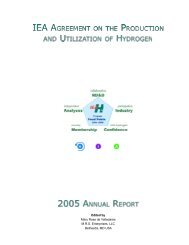Technology Status of Hydrogen Road Vehicles
Technology Status of Hydrogen Road Vehicles
Technology Status of Hydrogen Road Vehicles
Create successful ePaper yourself
Turn your PDF publications into a flip-book with our unique Google optimized e-Paper software.
on time scales that range from instantaneous to a few years. All originate in settings that are somewhat<br />
remote; without a suitable vector, they may never make much impact, especially on urban transport. <strong>Hydrogen</strong><br />
is such a vector, and in its pure form does not disturb the environmental merits <strong>of</strong> clearens. Whether it should<br />
be used alone or in combination with a carrier (e.g., methanol is a liquid carrier similar to other oil products;<br />
reduced iron is a carrier similar to ore) is still an open question. In fact, there may be several competitive<br />
approaches to what may become a major shipping industry that will bring clearens from remote to<br />
industrialized areas.<br />
This report does not define the technological status <strong>of</strong> these approaches to bulk hydrogen production and<br />
transport. For present purposes, large quantities are not necessary to fuel a limited number <strong>of</strong> prototype and<br />
small-fleet demonstrations <strong>of</strong> hydrogen vehicles. Even when the niche markets imposed by regional<br />
legislation become reality, clearen-derived hydrogen is not a must; any local supply <strong>of</strong> hydrogen such as<br />
refinery <strong>of</strong>f gases or even electrolyzers powered by local electricity will suffice. The point is, there is nothing<br />
wrong with decoupling early hydrogen vehicles from clearen-derived hydrogen; any hydrogen will do.<br />
Storage batteries are accepted as the motive power for zero-emission vehicles (ZEVs) and they, like<br />
home/local electrolyzers, simply shift the fossil fuel pollution, albeit much reduced, from local to power plant<br />
settings. In some vehicle applications such as fuel cells (FCs), the impurity levels in the hydrogen could be<br />
important. However, water electrolysis (which seems to be the front runner in clearen-derived hydrogen) is<br />
very pure (>99.999%).<br />
There is increased emphasis in the 11th WHEC (see Appendix 4) on hydrogen derived from hydrocarbon<br />
sources, especially by reforming <strong>of</strong> methane or methanol; this trend will be discussed throughout the report.<br />
Moore and Raman (1996) and Ogden (1996) examine various options <strong>of</strong> putting hydrogen into the vehicles<br />
in cities.<br />
2.2 Urban Distribution<br />
<strong>Hydrogen</strong> distribution is, especially in an urban setting, less straightforward than that <strong>of</strong> almost any other gas<br />
or liquid fuel. Even if town gas (before the arrival <strong>of</strong> natural gas) contained considerably more hydrogen, it<br />
still could not be compared to pure hydrogen from handling and safety points <strong>of</strong> view. In fact, hydrogen’s<br />
interface with the public is one <strong>of</strong> its main hurdles. This interface is dominated by safety concerns, both real<br />
and perceived.<br />
The real safety questions have received considerable attention, and will always be integral to vehicle design<br />
and operation. They are fundamental to any hydrogen application (especially urban transport); the important<br />
results are summarized in Appendix 1.<br />
The safety <strong>of</strong> hydrogen is so different from that <strong>of</strong> conventional fuels that simple comparisons can be<br />
misleading. The precise application is critical. In general, if hydrogen is properly handled, its safety potential<br />
exceeds conventional hydrocarbon fuels; improperly handled (especially if it leaks in confined spaces), it can<br />
be more explosive. Designing and operating hydrogen vehicles to guarantee adequate safety are matters for<br />
engineers and regulatory authorities. <strong>Hydrogen</strong> should not affect driving or life styles, unless vehicles are<br />
parked in garages or other confined spaces that do not have proper and guaranteed ventilation.<br />
The automotive industry has usually listened to the experts about safety issues, especially since the 1960s<br />
when safety moved to the forefront <strong>of</strong> most designs. But that is not true <strong>of</strong> all industries: the Challenger<br />
accident is a reminder <strong>of</strong> what happens when other pressures overwhelm safety. The measures available to<br />
keep safety at the forefront are discussed in Appendix 1.<br />
The perceived safety questions can be more intractable, particularly in a startup phase <strong>of</strong> hydrogen vehicles.<br />
2













